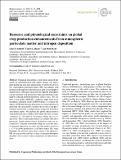| dc.contributor.author | Kelly, David | |
| dc.contributor.author | Schiferl, Luke Daniel | |
| dc.contributor.author | Heald, Colette L. | |
| dc.date.accessioned | 2018-08-06T15:22:59Z | |
| dc.date.available | 2018-08-06T15:22:59Z | |
| dc.date.issued | 2018-07 | |
| dc.date.submitted | 2018-06 | |
| dc.identifier.issn | 1726-4189 | |
| dc.identifier.uri | http://hdl.handle.net/1721.1/117276 | |
| dc.description.abstract | Changing atmospheric composition, induced primarily by industrialization and climate change, can impact plant health and may have implications for global food security. Atmospheric particulate matter (PM) can enhance crop production through the redistribution of light from sunlight to shaded leaves. Nitrogen transported through the atmosphere can also increase crop production when deposited onto cropland by reducing nutrient limitations in these areas. We employ a crop model (pDSSAT), coupled to input from an atmospheric chemistry model (GEOS-Chem), to estimate the impact of PM and nitrogen deposition on crop production. In particular, the crop model considers the resource and physiological restrictions to enhancements in growth from these atmospheric inputs. We find that the global enhancement in crop production due to PM in 2010 under the most realistic scenario is 2.3, 11.0, and 3.4 % for maize, wheat, and rice, respectively. These crop enhancements are smaller than those previously found when resource restrictions were not accounted for. Using the same model setup, we assess the effect of nitrogen deposition on crops and find modest increases (∼2 % in global production for all three crops). This study highlights the need for better observations of the impacts of PM on crop growth and the cycling of nitrogen throughout the plant-soil system to reduce uncertainty in these interactions. | en_US |
| dc.description.sponsorship | Martin Family Society of Fellows for Sustainability | en_US |
| dc.description.sponsorship | Massachusetts Institute of Technology. Abdul Latif Jameel World Water and Food Security Lab | en_US |
| dc.publisher | Copernicus GmbH/European Geosciences Union | en_US |
| dc.relation.isversionof | http://dx.doi.org/10.5194/bg-15-4301-2018 | en_US |
| dc.rights | Creative Commons Attribution 4.0 International License | en_US |
| dc.rights.uri | http://creativecommons.org/licenses/by/4.0/ | en_US |
| dc.source | Biogeosciences | en_US |
| dc.title | Resource and physiological constraints on global crop production enhancements from atmospheric particulate matter and nitrogen deposition | en_US |
| dc.type | Article | en_US |
| dc.identifier.citation | Schiferl, Luke D., Colette L. Heald, and David Kelly. “Resource and Physiological Constraints on Global Crop Production Enhancements from Atmospheric Particulate Matter and Nitrogen Deposition.” Biogeosciences 15, no. 14 (July 17, 2018): 4301–4315. | en_US |
| dc.contributor.department | Massachusetts Institute of Technology. Department of Civil and Environmental Engineering | en_US |
| dc.contributor.department | Massachusetts Institute of Technology. Department of Earth, Atmospheric, and Planetary Sciences | en_US |
| dc.contributor.mitauthor | Schiferl, Luke Daniel | |
| dc.contributor.mitauthor | Heald, Colette L. | |
| dc.relation.journal | Biogeosciences | en_US |
| dc.eprint.version | Final published version | en_US |
| dc.type.uri | http://purl.org/eprint/type/JournalArticle | en_US |
| eprint.status | http://purl.org/eprint/status/PeerReviewed | en_US |
| dc.date.updated | 2018-08-03T13:26:37Z | |
| dspace.orderedauthors | Schiferl, Luke D.; Heald, Colette L.; Kelly, David | en_US |
| dspace.embargo.terms | N | en_US |
| dc.identifier.orcid | https://orcid.org/0000-0002-5047-2490 | |
| dc.identifier.orcid | https://orcid.org/0000-0003-2894-5738 | |
| mit.license | PUBLISHER_CC | en_US |
